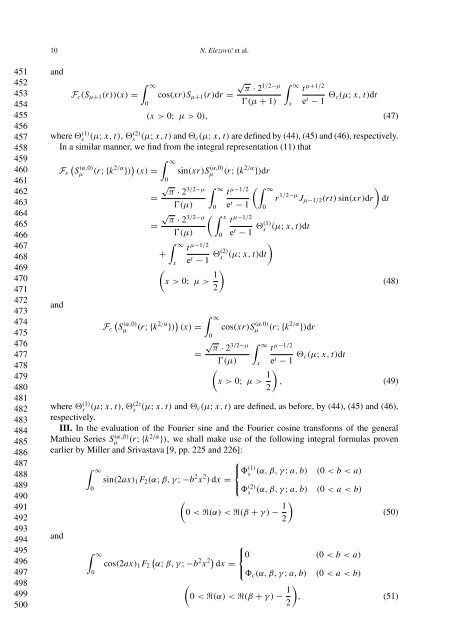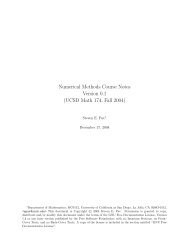Integral representations and integral transforms of some families of ...
Integral representations and integral transforms of some families of ...
Integral representations and integral transforms of some families of ...
Create successful ePaper yourself
Turn your PDF publications into a flip-book with our unique Google optimized e-Paper software.
10 N. Elezović et al.<br />
451<br />
452<br />
453<br />
454<br />
455<br />
456<br />
457<br />
458<br />
459<br />
460<br />
461<br />
462<br />
463<br />
464<br />
465<br />
466<br />
467<br />
468<br />
469<br />
470<br />
471<br />
472<br />
473<br />
474<br />
475<br />
476<br />
477<br />
478<br />
479<br />
480<br />
481<br />
482<br />
483<br />
484<br />
485<br />
486<br />
487<br />
488<br />
489<br />
490<br />
491<br />
492<br />
493<br />
494<br />
495<br />
496<br />
497<br />
498<br />
499<br />
500<br />
<strong>and</strong><br />
F c (S μ+1 (r))(x) =<br />
√ π · 2<br />
1/2−μ<br />
∫ ∞<br />
t μ+1/2<br />
cos(xr)S μ+1 (r)dr =<br />
0<br />
Ɣ(μ + 1) x e t − 1 c(μ; x,t)dt<br />
(x > 0; μ>0), (47)<br />
∫ ∞<br />
where (1)<br />
s (μ; x,t), (2)<br />
s (μ; x,t) <strong>and</strong> c (μ; x,t) are defined by (44), (45) <strong>and</strong> (46), respectively.<br />
In a similar manner, we find from the <strong>integral</strong> representation (11) that<br />
<strong>and</strong><br />
F s<br />
(<br />
S<br />
(α,0)<br />
μ (r;{k 2/α }) ) (x) =<br />
∫ ∞<br />
0<br />
sin(xr)S μ<br />
(α,0) (r;{k 2/α })dr<br />
∫ ∞<br />
t μ−1/2 (∫ ∞<br />
)<br />
r 1/2−μ J<br />
Ɣ(μ) 0 e t μ−1/2 (rt) sin(xr)dr dt<br />
− 1 0<br />
( ∫ x<br />
t μ−1/2<br />
Ɣ(μ) 0 e t − 1 (1) s (μ; x,t)dt<br />
t μ−1/2<br />
)<br />
(μ; x,t)dt<br />
√ π · 2<br />
3/2−μ<br />
=<br />
√ π · 2<br />
3/2−μ<br />
=<br />
+<br />
∫ ∞<br />
x<br />
e t − 1 (2) s<br />
)<br />
(<br />
x>0; μ> 1 2<br />
F c<br />
(<br />
S<br />
(α,0)<br />
μ (r;{k 2/α }) ) (x) =<br />
∫ ∞<br />
0<br />
cos(xr)S μ<br />
(α,0) (r;{k 2/α })dr<br />
√ π · 2<br />
3/2−μ<br />
=<br />
Ɣ(μ)<br />
∫ ∞<br />
t μ−1/2<br />
x<br />
(<br />
x>0; μ> 1 2<br />
(48)<br />
e t − 1 c(μ; x,t)dt<br />
)<br />
, (49)<br />
where (1)<br />
s (μ; x,t), (2)<br />
s (μ; x,t) <strong>and</strong> c (μ; x,t) are defined, as before, by (44), (45) <strong>and</strong> (46),<br />
respectively.<br />
III. In the evaluation <strong>of</strong> the Fourier sine <strong>and</strong> the Fourier cosine <strong>transforms</strong> <strong>of</strong> the general<br />
Mathieu Series S μ<br />
(α,β) (r;{k 2/α }), we shall make use <strong>of</strong> the following <strong>integral</strong> formulas proven<br />
earlier by Miller <strong>and</strong> Srivastava [9, pp. 225 <strong>and</strong> 226]:<br />
⎧<br />
∫ ∞<br />
⎨ (1)<br />
sin(2ax) 1 F 2 (α; β,γ;−b 2 x 2 s (α, β, γ ; a,b) (0














